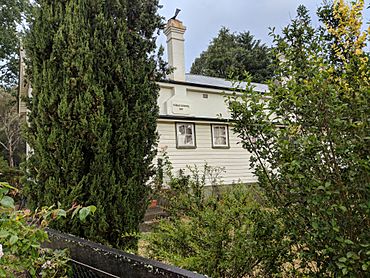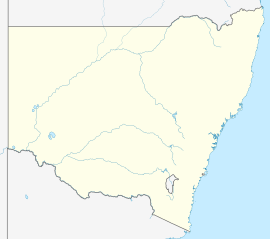Majors Creek, New South Wales facts for kids
Quick facts for kids Majors CreekNew South Wales |
|||||||||||||||
|---|---|---|---|---|---|---|---|---|---|---|---|---|---|---|---|

The former Majors Creek School, now a residence
|
|||||||||||||||
| Population | 290 (2021 census) | ||||||||||||||
| Established | 1851 | ||||||||||||||
| Postcode(s) | 2622 | ||||||||||||||
| Elevation | 700 m (2,297 ft) | ||||||||||||||
| Location | |||||||||||||||
| LGA(s) | Queanbey–Palerang | ||||||||||||||
| Region | Southern Tablelands | ||||||||||||||
| County | St Vincent | ||||||||||||||
| Parish | Elrington | ||||||||||||||
| State electorate(s) | Monaro | ||||||||||||||
| Federal Division(s) | Eden-Monaro | ||||||||||||||
|
|||||||||||||||
Majors Creek is a small village in the Southern Tablelands region of New South Wales, Australia. It is about 16 kilometers south of the larger town of Braidwood. In 2021, 290 people lived in Majors Creek.
This village was once a busy gold mining town. Today, it is known for the Dargues Reef gold mine, which is still active. The name Majors Creek also refers to the surrounding area for mail and official records.
Contents
Where is Majors Creek?
Majors Creek is located on high ground, east of the Great Dividing Range. This area is close to where water flows in different directions. Some water goes into the Shoalhaven River system, and some flows into the Deua-Moruya River system.
The village sits on the upper part of a stream also called Majors Creek. This stream flows into Araluen Creek, which is part of the Deua-Moruya river system. Other nearby streams, like Back Creek and Jembaicumbene Creek, flow into the Shoalhaven River.
Traditional Owners
The land where Majors Creek is located belongs to the Walbanga people. They are a group within the larger Yuin Aboriginal nation. Walbanga people lived in the Majors Creek area until the early 1900s.
In the late 1800s, many Aboriginal people living in the goldfields near Braidwood moved closer to the coast. This area was also Walbanga country. They likely moved to find better ways to live and get food.
Early European Settlement
After European settlers arrived, Majors Creek became part of the Nineteen Counties. These were areas open for settlement. Major William Sandys Elrington received land nearby in 1831. His property was called 'Mount Elrington'.
Around 1840, a settlement officially named Elrington began. However, after gold was found in 1851, it became better known as Majors Creek. Both names come from Major William Sandys Elrington.
Major Elrington had a long military career before moving to Australia in 1827. He sold his land and left Australia in 1846. This means he did not benefit from the gold discovery five years later.
Gold Rush History
In 1851, Mrs. Baxter discovered alluvial gold in Majors Creek. Alluvial gold is found in riverbeds. Soon, about 2,000 miners were working there, each finding a lot of gold every day.
This easy-to-find gold lasted until about 1856. During this time, the mining caused a lot of damage to the creek and its banks. You can still see some of this damage today.
From 1869 to 1874, miners started quartz reef mining. This meant digging deeper into the ground to find gold in rock veins. Majors Creek was not good for gold dredge mining. This type of mining happened in other nearby goldfields like Jembaicumbene and Araluen in the early 1900s.
By 1914, most gold mining in Majors Creek had stopped. There was an attempt to restart mining in the 1930s, but it was not very successful. The last of the old mines closed during World War II. Until July 2024, there was modern gold mining at the Dargues Reef mine in the area.
Village Life and Buildings
In 1858, a town plan for Elrington was drawn up. The village's only business today, a hotel and post office, is still called the Elrington Hotel. The current hotel building was built in 1913. It replaced an older hotel across the street.
In its busiest times, Majors Creek had many services. It had a police station, a post office, several churches, and schools. There were also four hotels and 24 stores. Most buildings from the gold rush era were made of timber. Few of them are still standing today.
The Ben Hall Incident
On March 13, 1865, the famous bushranger Ben Hall and his gang attacked the Araluen gold escort. This happened just outside Majors Creek, on the old mountain road.
Constable John Kelly was badly hurt in the attack. The driver, John Blatchford, was slightly injured. He managed to run to Araluen for help. Constable Daniel Byrne bravely protected the gold. The other two police officers tried to surround the bushrangers. Ben Hall's gang escaped without any gold.
The wagon that carried the gold is now kept at the Braidwood Museum. Only a few weeks later, police shot and killed Ben Hall near Forbes. There is a marker at the site of the attack in Majors Creek.
Education and Structures
Majors Creek had a public school from 1857 to 1967. The old school building, built in 1889, is in a part of Majors Creek once known as Inkley.
In the 1870s, an Italian stonemason named Peter Rusconi built important stone structures. He built the stone parts of the bridge over Majors Creek on the main road. He also built St Stephen’s Anglican Church.
Local Events
The village is also home to the "Music At The Creek" festival. This event happens every two years.


